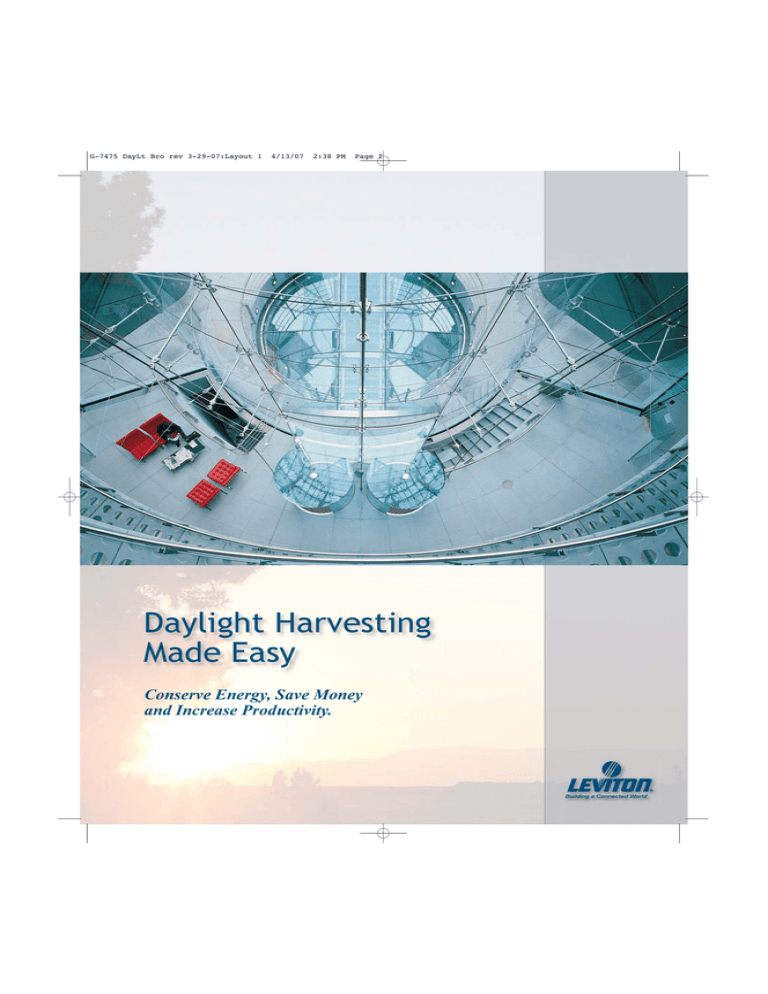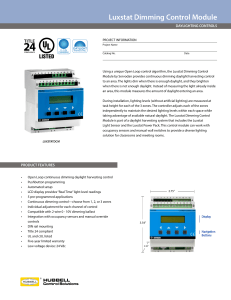
G-7475 DayLt Bro rev 3-29-07:Layout 1
4/13/07
2:38 PM
Page I
Daylight Harvesting
Made Easy
Conserve Energy, Save Money
and Increase Productivity.
G-7475 DayLt Bro rev 3-29-07:Layout 1
4/13/07
2:38 PM
Page II
Overview
Faced with the skyrocketing cost of energy and environmental concerns, builders,
architects and lighting specialists are increasingly turning to daylighting as a primar y
source of illumination in mainstream construction. Daylighting will provide tremendous
operating cost reductions if properly integrated with an electrical
lighting control system.
At the same time, proper daylighting can increase the comfor t and
productivity of a building’s occupants. It provides superior quality
light for a wide range of tasks in the workplace. Windows,
skylights and other clearstories used for daylight
integration can also improve ventilation, lower air
conditioning costs, and provide workers with visual
stimulation. Exposure to both daily and seasonal
cycles of natural daylight has also been shown to
positively affect both the mood and stress
levels of occupants.
For successful daylight integration, cer tain
principles need to be followed in terms of
optimum building placement: the location,design
and selection of materials for fenestration
(windows, skylights, etc.) and electrical lighting
design. In general, the earlier in the design process
of new buildings that daylighting issues are
addressed, the more successful the daylight
har vesting project will be.
To take full advantage of daylight integration,
buildings should have automated controls that
either turn off or dim ar tificial lighting in
response to the available daylight in the space.
This is traditionally called “daylight har vesting.”
G-7475 DayLt Bro rev 3-29-07:Layout 1
4/13/07
2:38 PM
Page 1
A Closer Look at the Advantages
of Daylight Harvesting
Greater Health, Well-Being
and Productivity
There is strong evidence that daylighting
can improve the health, well-being and
productivity of occupants. Daylight generally
has a high color temperature, high color
rendition and is rich in blue radiation. Both
good color identification and improved
visibility are attributed to these factors.
People generally describe daylight as providing
better visual clarity and color differentiation.
One 2003 study of office workers in
California1 confirmed that workers exposed
to daylight through a window with a view
versus those with no window performed
10-25% better on mental functioning and
memory recall tests. On the other hand, the
study also found that glare from windows
was associated with poorer office worker
performance. Greater glare caused
performance on three mental function tests
to decrease by 15-21%. Clearly, daylighting needs to be carefully
planned to reap its benefits while avoiding the pitfalls.
Although artificial lighting is an integral part of modern living, the
positive effects of daylight remain unchanged. Daylight provides a
connection to the outdoors and supplies occupants with information
on time of day, the seasons and weather conditions. In so doing, it
keeps occupants more alert by providing frequent changes in focal
distance, which helps eye muscles to relax. Whether associated with
a view or not, daylight also entrains and reinforces circadian rhythms,
helps to maintain daily sleep cycles, avoids seasonal affective disorder
and more. Lastly, research in Sweden measuring cortisol (a stress
hormone) levels in school children also found that working in
classrooms without daylight adversely affected concentration and
cooperation and eventually impacted developmental issues and
frequency of absences due to illness.
Increased Energy Savings
With lighting accounting for approximately 38% of all energy
consumed in modern buildings, daylight harvesting can significantly
lower energy costs by providing illumination while allowing electric
lighting to be automatically dimmed or switched off. Daylight
harvesting also produces a lower cooling load than electric lighting
for the same amount of illumination, resulting in lower cooling costs.
This assumes that the daylight integration will be thoughtfully
designed to avoid glare and overheating. In the end, to achieve high
quality lighting and produce energy savings, daylighting and electric
lighting systems must be designed together so they complement
each other. Lighting controls are a major area of integration for these
two sources of illumination.
Daylight harvesting starts with lighting controls that are flexible
enough to accommodate the changing requirements of occupants in
a space. Factors such as bi-level and multi-level switching or dimming
capability as well as separate circuiting of luminaires in daylighted
zones enhance both the usability of a space and energy savings.
Control flexibility improves lighting energy performance by
establishing a base level of illumination and then encouraging the use
of only those lights that are needed for the activity at hand. It also
increases occupant satisfaction through user control.
On the other hand, while some occupants are quite conscientious
about manually “tuning” lighting for their needs, including turning off
or dimming lighting when not needed, automatic systems tend to
result in greater energy savings over the long run. They should always
be supplemented with manual override to accommodate individual
differences. Automated systems usually include optical sensors
(photocells) that read ambient light levels to both maintain a base
level of illumination, by using as much free natural daylight as possible,
and occupancy sensors to shut lights off when spaces are unoccupied.
Depending on the level of sophistication of the system, it might also
include time scheduling capability, load shedding, an HVAC interface,
and other lighting control strategies to extend the energy-savings
generated by a daylight harvesting system.
1
Windows and Offices: A Study of Office worker Performance
and the Indoor Environment – CEC PIER 2003 (Heschong Mahone)
Daylight Har vesting Made Easy • 1
G-7475 DayLt Bro rev 3-29-07:Layout 1
4/13/07
2:38 PM
Page 2
Key Issues of Daylight Harvesting Design
From a lighting perspective, daylight can
be treated as any other light source and
used to compose lighting design solutions
with illuminance, luminance, contrast, color
and other lighting design elements. The
best daylight harvesting designs are
initiated early in the design process of
new buildings when building orientation
and location of fenestration – the glazed
entry points of daylight – are decided.
Designers should also fully assess the
availability of daylight prior to design of
the electrical lighting system.
Optimizing a Building’s Orientation
A building’s orientation must be optimized so that its position
allows maximum daylight while minimizing unwanted solar gains.
This is easiest to achieve with north-facing windows as sunlight
only strikes a north-facing window in early morning and late
evening during the midsummer period. South-facing windows are
the next best option because of the high angle of the sun, which
can be easily shaded using horizontal overhangs. Windows that
face in an easterly or westerly direction, where the sun is low in
the sky, are more problematic as overhangs or other fixed shading
devices are of limited utility in controlling glare. Any window
orientation that is more than 15° off of true north or south
requires careful assessment to avoid unwanted sun penetration.
Extreme northern latitudes are the exception and care must be
taken in the design of south-facing windows because of the low
altitude of the sun during the winter.
Optimizing the Effects of Fenestration
In addition to windows, fenestration can also include glazed
doors, skylights and other forms of top lighting. The placement,
design and the selection of fenestration materials are also
extremely impor tant and can tip the balance between a highand low-performance building. Fenestration impacts building
energy efficiency by affecting cooling loads, heating loads, and
lighting loads. Visual comfor t is also strongly impacted by
window location, shading, and glazing materials. Well-designed
windows can be a visual appeal while poorly designed windows
can create a major source of glare. Thermal comfor t can also be
compromised by poor fenestration design. Poorly insulated
windows render a space too cool in the winter and too hot in
the summer. Windows with low U-values can improve thermal
comfor t by keeping glass surface temperatures closer to the
interior air temperature. In addition, east-west windows and
unshaded south windows can cause excessive cooling loads.
Windows and skylights provide oppor tunities for natural
ventilation, but they must also be designed to ensure a safe,
secure, and easily maintained facility.
2 • Daylight Har vesting Made Easy
Defining the Daylight Harvesting
Opportunities of a Building
Daylight har vesting
oppor tunities can be
best described as
standard, advanced or
integrated depending on
the following scenarios:
• Standard: The
architecture, building
orientation,
fenestration and
daylighting
oppor tunities are
“fixed” when the
daylight harvesting
design process star ts.
The focus is on lighting
controls. The designer’s
key concerns are
whether daylight can
provide useful
illumination during
occupied hours and if any electric lighting can be circuited for
manual or automatic dimming or switching in response.
• Advanced: The lighting designer has the oppor tunity to
influence some of the building’s glazing proper ties, shade
controls and other features to improve the benefits of
daylight harvesting. The focus is on quantifying the
contribution of daylight harvesting and glare management. In
this scenario, the designer would recommend external shading
devices or internal window controls such as blinds to allow
occupants to make adjustments to ensure comfor t. For
skylights or roof monitors, they would also recommend
diffusing glazing, baffles or louvers to diffuse sunlight. Working
with the design team, they would also evaluate the impact of
changes in glazing performance, assess the effect of potential
G-7475 DayLt Bro rev 3-29-07:Layout 1
4/13/07
2:38 PM
Page 3
glare sources such as white or bright reflective surfaces on
occupants and help define any repositioning of occupant’s
activities needed to avoid potential sources of glare.
Automated, daylight-responsive controls should be
incorporated in areas with daylight contributions.
• Integrated: An in-depth analysis is performed on the daylight
harvesting potential of a building at the earliest possible stage
before construction. The focus is on architectural solutions and
their full integration with electric lighting and lighting controls to
provide high quality daylight illumination. The designer would
evaluate if the quality, distribution or amount of daylighting could
be improved during pre-design and schematic design phases.
Modeling software would be used to evaluate the full integration
of daylight harvesting and electric lighting controls with buildings
characteristics. A thorough evaluation encompasses testing
window placements for maximum distribution of daylight,
including ceiling plane adjustments, the effect of adjusting light
transmission levels of windows, and the consequences of the
position and level of reflectivity of surfaces, either internally or
externally, to direct daylight more deeply into the building’s
interior. Total building automated lighting controls are used to
maximize daylight harvesting benefits and energy savings.
Predicting Potential Savings from
Daylight Harvesting
From an energy perspective, the most obvious use of daylight is
to permit dimming or switching off of the electric lighting
system. However, predicting energy savings based on available
daylight is not easy. As these savings often justify the added cost
of daylighting integration elements, such as dimming ballasts and
photoelectric controls, predicting potential savings with some
cer tainty is a very impor tant and powerful tool. The savings can
best be described as providing minimal, good or optimal control
depending on the following scenarios:
Potential Savings from Daylight Harvesting
Strategy
Savings
Issues
Products
Minimal Control:
Either separate bi-level manual
switching for overhead lights
within 15’ of all perimeter
windows, or occupancy sensors
with Ambient Light Hold-OFF
feature. Task lights should have
local switching.
Consumption will be reduced
10 to 20% in areas with daylight
contribution.
Occupant preference and
training in the use of daylighting
controls will result in the most
significant energy savings. This
strategy is most beneficial in
owner- occupied buildings.
Leviton standard line-voltage
switch for bi-level approach.
Leviton ceiling, wall or wall box
occupancy sensors.
Good Control:
Same as above, but add manual
dimming in place of switching
schemes.
The average savings has shown
to be 25% with the addition of
manual dimming.
Fluorescent dimming ballasts can
add $0.25 to $0.75 per square
foot to system cost. Energy
savings can offset incremental
costs quickly.
Same as above, plus Leviton wall
box fluorescent dimmer
controls.
Optimal Control:
Automatic daylight harvesting
controls in all areas with daylight.
Should be connected to whole
building automation controls
with occupancy sensors for
optimal savings.
Studies performed by LBL* have
shown energy savings as much
as 45% when an integrated
daylighting control system is
used with scheduling and
occupancy sensors.
*Lawerence Berkley Laboratory
Savings will be dependent on
the typical occupant use of the
space. Occupant satisfaction is
very high with this approach.
Leviton miniZ Daylight
Harvesting System networked
with a Z-MAX building lighting
automation relay controller.
Daylight Har vesting Made Easy • 3
G-7475 DayLt Bro rev 3-29-07:Layout 1
4/13/07
2:39 PM
Page 4
Typical Diagrams For Minimal,
Good and Optimal Control
Minimal Control with
Photocell Hold-Off Feature
Basic bi-level switching is achieved with
a mix of manual switches and Leviton
Occupancy Sensors with Ambient Light
Hold-Off. This allows some or all of the
lights to remain off when natural lighting
reaches a comfortable level, reducing
electrical consumption.
Occupancy Sensor
OSC or OSW Type
OSP Series
Power Pack
Breaker Panel
(By Others)
Optional Manual
Override Switch
5621-X
Fluorescent Load
Non-Dimming
4 • Daylight Har vesting Made Easy
Incandescent Load
G-7475 DayLt Bro rev 3-29-07:Layout 1
4/13/07
2:39 PM
Page 5
Occupancy Sensor
OSC or OSW Type
Good Control with Photocell Hold-Off Feature
Installing dimmers in place of ON/OFF switches enhances bi-level
switching. Leviton Occupancy Sensors with Ambient Light Hold-Off
allows some or all of the lights to remain off when natural lighting
reaches a comfortable level. Dimmers provide occupants with the
ability to fine-tune lighting levels for maximum comfort, further
reducing electrical consumption.
OSP Series
Power Pack
Incandescent Load
Breaker Panel
(By Othera)
Optional IllumaTech
Wall Dimmer
IPI06-IP &
IPI06-DL
OSA20 Add-a-Relay
Fluorescent Load
Mark 7TM Dimming*
Occupancy Sensor
OSC or OSW Type
Optimal Control with Automatic Daylight Harvesting
Leviton's miniZ Daylight Harvesting Controller provides optimal
balance of natural and artificial lighting for maximum comfort and
energy-savings. The photocell measures the ambient light and the
miniZ adjusts dimmable fluorescent fixtures accordingly to achieve
user-preset illumination levels. The occupancy sensor ensures that
lights remain off when the space is unoccupied. Low-voltage wall
switch stations provide convenient manual control. The miniZ
features Ladder-less Commissioning – Illumination level can be
easily set from wall switch station without having to use a ladder to
access controller unit.
Photocell
ODCOP-00W
Fluorescent Load
Mark 7TM Dimming*
Fluorescent Load
Mark 7TM Dimming*
Breaker Panel
(By Others)
*Mark 7™ is is a trademark
of Advance Transformer Company.
miniZ Daylight
Harvesting System
MDZ30
Fluorescent Load
Mark 7TM Dimming*
miniZ 5 button
control station
Daylight Har vesting Made Easy • 5
G-7475 DayLt Bro rev 3-29-07:Layout 1
4/13/07
2:39 PM
Page 6
Daylight Harvesting Applications
Multi-Technology
Occupancy Sensor
(OSW12)
Power Pack (OSP20)
Junction
Box
On/Off Switches
(5621)
Basic Windowless Classroom
Whiteboard
On/Off Switch
(5621)
Low-voltage
Dimmer Switch
(LV200)
Wide-View
Occupancy Sensor
(OSWWV)
ZONE 3
ZONE 1
miniZ
ZONE 2
Low-voltage
On/Off
Switch
(LV240)
Advanced Classroom
with Windows
Photocell
(ODC0P)
6 • Daylight Har vesting Made Easy
miniZ Daylight
Harvesting
System
(MZD30)
G-7475 DayLt Bro rev 3-29-07:Layout 1
4/13/07
2:39 PM
Page 7
Gymnasium
Low-voltage Switch (LV240)
2
1
2
2
1
2
2
1
2
Wide View
Occ. Sensor
(OSWWV)
2
1
2
ZONE 2
2
1
2
miniZ Daylight
Harvesting
System
(MZD30)
2
1
2
2
1
2
ZONE 1
2
1
2
miniZ
Photocell
(PCSKY)
2
1
2
Wide View Occ. Sensor
(OSWWV)
2
1
2
2
1
2
2
1
2
miniZ
Daylight
Harvesting
System
(MZB20)
Low-voltage Switch
(LV240)
Daylight Har vesting Made Easy • 7
G-7475 DayLt Bro rev 3-29-07:Layout 1
4/13/07
2:39 PM
Page 8
Networked School
Photocell
(ODC0P)
Advanced
Classrooms
Photocell
(ODC0P)
miniZ
miniZ
miniZ Daylight
Harvesting System
(MZN30)
Junction Box
Remote Relay Panel (RRP)
Basic
Classrooms
Wide View
Occ. Sensor
(OSWWV)
2
1
2
2
1
2
2
1
2
2
1
2
2
1
2
Low-voltage
Switch
(LV240)
2
1
2
Photocell
(PCSKY)
Gymnasium
2
1
2
2
1
2
2
1
2
ZONE 1
miniZ
8 • Daylight Har vesting Made Easy
2
1
2
2
1
2
2
1
2
Networkable
Z-MAX
Cabinet with
Breakers
miniZ Daylight
Harvesting System
(MZN20)
ZONE 2
Low-voltage Switch
(LV240)
Wide View
Occ. Sensor
(OSWWV)
G-7475 DayLt Bro rev 3-29-07:Layout 1
4/13/07
2:39 PM
Page 9
5-Button
Low Voltage
Dimmer Station
(LV200)
Advanced Office with Windows
Ceiling
Occupancy
Sensor
(OSC20-U0W)
miniZ
miniZ
Daylight
Harvesting
System
(MZD30)
Photocell
(ODCOP)
ZONE 1
ZONE 2
ZONE 3
Daylight Har vesting Made Easy • 9
G-7475 DayLt Bro rev 3-29-07:Layout 1
4/13/07
2:39 PM
Page 10
Leviton Manufacturing Co., Inc.
59-25 Little Neck Parkway, Little Neck, NY 11362-2591
Telephone: 1-800-833-3532 • FAX: 1-800-832-9538 • Email: info@leviton.com
Tech Line (8:30AM-7:30PM E.S.T. Monday-Friday): 1-800-824-3005
Leviton Manufacturing of Canada, Ltd.
165 Hymus Boulevard, Pointe Claire, Quebec H9R 1E9
Telephone: 1-800-469-7890 • FAX: 1-800-563-1853
Leviton S. de R.L. de C.V.
Lago Tana 43, Mexico DF, Mexico CP 11290
Telephone: (+52) 55-5082-1040 • www.leviton.com.mx
Visit Leviton’s Website at www.leviton.com
© 2007 Leviton Manufacturing Co., Inc. All rights reserved.
G-7475/C7 sw
C7


